It does not matter what you call it or how you explain it. The Trump Trade. A tax reform rally. Heck, you can attribute the longest S&P 500 uptrend in history without a 3% pullback to global quantitative easing (QE). It makes very little difference. Stocks have been stupendous.
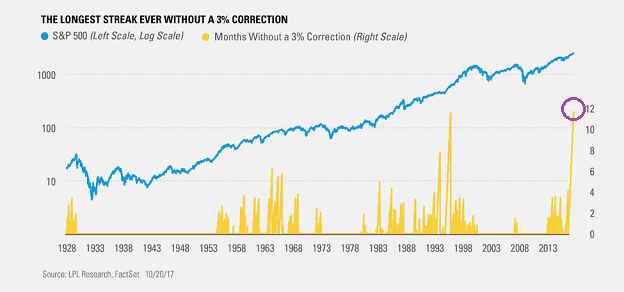
Does a record number of trading days without a 3% correction mean anything? Not in isolation. The second-longest streak occurred between January 1995 and January 1996. And yet, back then, the phenomenal ’90s stock bull was only in the fifth inning of a record-breaking stretch (10/1990-3/2000).
On the other hand, the dearth of selling activity today is occurring at a moment when investors are more leveraged than ever before. They have never been more confident in future stock performance. The average cash allocation is the lowest on record, even lower than it was at the peak of dot-com euphoria (1/2000). Meanwhile, previous periods of relative equanimity – trading sessions with less than a 5% correction – preceded major financial crises and severe stock bears.

There’s more. A number of investors have been piling on the ‘no-vol’ train by shorting the CBOE S&P 500 Volatility Index (VIX). Shorting VIX futures has been so profitable for so long, they’ve become like pigs eating at the trough. And now, the positioning appears to represent a few too many people standing on one side of a crowded boat.
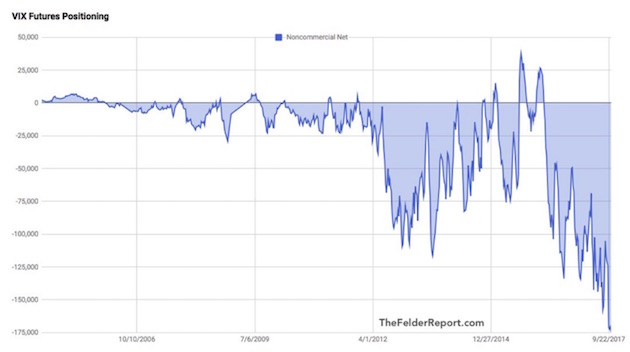
As if these issues were not enough, some market anomalies simply defy sensibility. For example, would you acquire a corporate bond of a junk-rated European corporation if it yields LESS THAN a comparable U.S. Treasury bond yield? Probably not. Nevertheless, world central bank distortions have created this exact scenario.
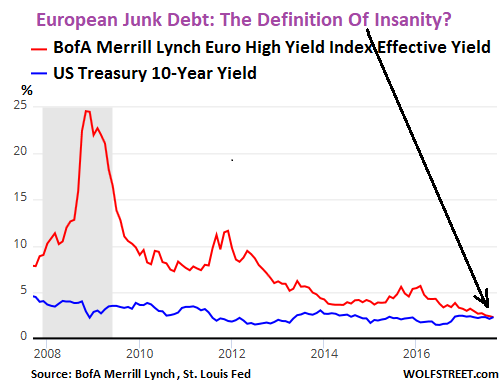
Some of these concerns might be ameliorated by ultra-low borrowing costs, but not all of them. For one thing, the popular 10-year yield has pushed to the upper limit of an intermediate-term range.
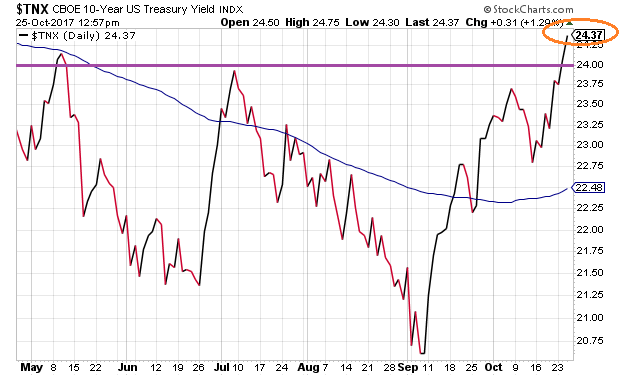
For another, earnings reports that have recently exceeded ‘lowered-bar’ expectations have done little to reduce extreme overvaluation. The median stock trades in the 98% of historical valuations. (Note: When one compares the 20 years between 1935 and 1954, he/she finds several decades with ultra-low interest rates at an average valuation that is HALF of what it is here in October of 2017.)

Indeed, an examination of earnings growth over the past three-and-a-half years since the start of 2014 tells us that earnings have NOT been the main force in driving prices higher. In reality, asset prices have climbed 35% since the start of 2014, whereas earnings have managed a whopping 2%.
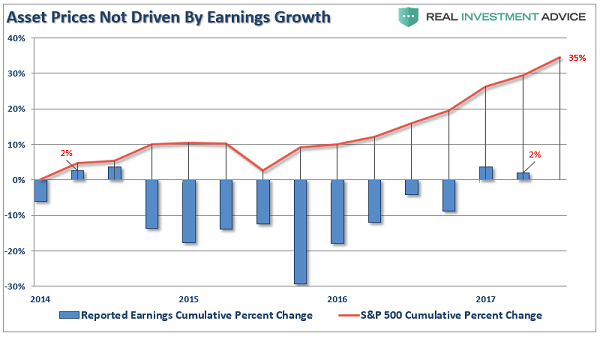
As I indicated earlier, it may not matter what has been causing the unbridled enthusiasm for risk taking. Earnings improvement over the 2015-2016 earnings recession may be a factor. Corporate tax cut hopes, investor exuberance and the ‘fear of missing out’ may be playing a part. Global repression of borrowing costs as well as the electronic printing of monetary credits may be influential as well. Regardless, to the extent you’ve been participating, your portfolio has been gaining ground.
Still, there are more than a few indications that the sailing in future months may be far from smooth. For instance, if the SPDR Gold Trust (NYSE:GLD) experienced ‘lower lows’ across five bearish years of price depreciation, what can we say about the 20 months of ‘higher lows?’ Has precious metal demand ratcheted up due to generalized diversification, or is the desire to own gold a reaction to massive electronic money creation by global central banks since January of 2016?
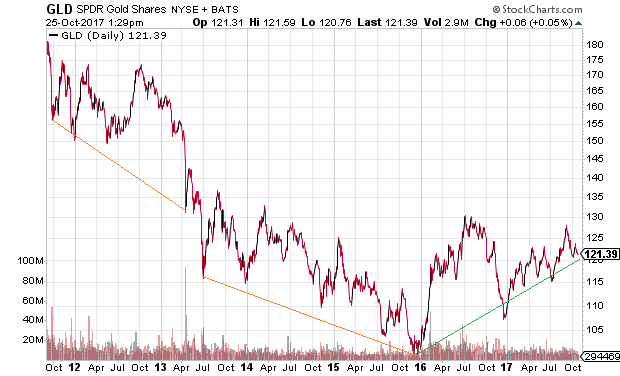
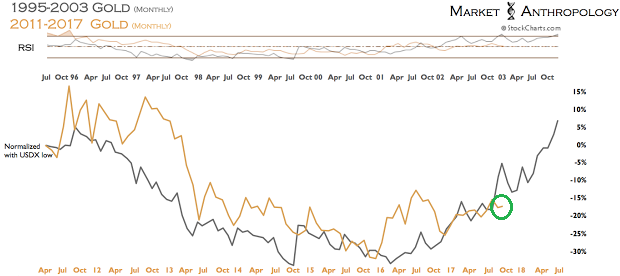
To the extent that the second longest bull run (3/2009-10/2017) in history is a function of ultra-easy monetary policies around the globe, investors may be in for more trouble than they are able to envision. Right now, some central banks are gearing up to ‘taper’ the amount of assets that they purchase with new electronic monetary credits. Similarly, the U.S. Federal Reserve has expressed a desire for quantitative tightening (QT) — a plan to let old bonds mature without reinvesting the electronic credits. In other words, if quantitative easing (QE) stimulated the economy as well as pushed asset prices higher through a ‘wealth effect,’ wouldn’t the opposite process (QT) slow the economy?
Supposedly, ‘fiscal stimulus’ via tax cuts will offset any drag from monetary tapering and/or monetary tightening. Perhaps this scenario is plausible. However, a leap of faith might be required. First of all, a change in the marginal tax bracket from 35% to 20% for corporations may be far less stimulative than many hope. The typical company currently pays about 24% after deductions, not 35%. If the tax package closes additional loopholes to justify cutting the marginal bracket down to 20%, the benefits of lowering the marginal bracket will be further minimized.
Second, the political leadership is adamant about serving up a ‘middle class tax cut’ as well as neutralizing any breaks for top earners. For better or worse, the top 20% who pay 88% of all federal tax revenue will not have additional dollars to consume anymore than they already do. (How, then, would the economy grow even faster?) A ‘middle class tax cut’ may be a good thing… maybe a wonderful thing. Yet the household savings are just as likely to go into paying down debt levels as for consumption.
The point? Investors may be placing a little too much faith in the notion that the eventual tax package – comprehensive or otherwise – can be massively stimulative for economic growth. Can it really fire up the weakening job growth picture, as well as withstand quantitative tightening (QT)?
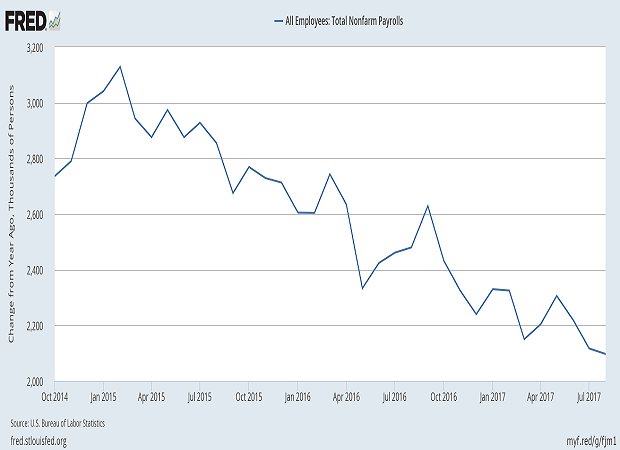
Bottom line? Stocks may continue to perform well in spite of fundamental and technical concerns. That said, I am holding a lower-than-normal allocation to stocks (e.g., 50%-55%) and to investment-grade debt (e.g., 20%) for my retiree and near-retiree client base. Whereas the rest of the investment community may want to have a 5% cash cushion, I am fine with a 20%-25% cash cushion that yields just 1.3%-1.5%. Not only will it reduce portfolio volatility when volatility returns, it will also be deployed when I can scoop up bargain assets at discounted prices.
Disclosure Statement: ETF Expert is a web log (“blog”) that makes the world of ETFs easier to understand. Gary Gordon, MS, CFP is the president of Pacific Park Financial, Inc., a Registered Investment Adviser with the SEC. Gary Gordon, Pacific Park Financial, Inc., and/or its clients may hold positions in the ETFs, mutual funds, and/or any investment asset mentioned above. The commentary does not constitute individualized investment advice. The opinions offered herein are not personalized recommendations to buy, sell or hold securities. At times, issuers of exchange-traded products compensate Pacific Park Financial, Inc. or its subsidiaries for advertising at the ETF Expert website. ETF Expert content is created independently of any advertising relationship.
